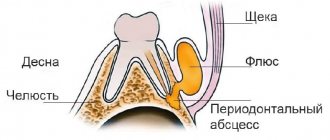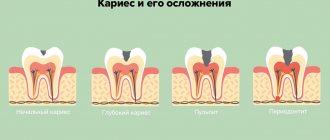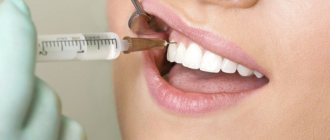Causes Symptoms Pain under a dental bridge How to relieve pain at home When a doctor's help is needed Dangerous consequences Prevention
Prosthetics is a multi-stage procedure, if all work is completed, the prosthesis is installed, but pain or discomfort under the crown bothers you - it’s time to figure out the source of the discomfort. To relieve pain under a crown, you first need to accurately determine the cause of its occurrence. Soreness can be caused by recurrent caries, periodontal damage, or associated with errors in the manufacture of orthopedic structures. The doctor will name the exact cause after a comprehensive diagnosis.
Pain syndrome can occur immediately after installation of the prosthesis, after a month, a year, or for a long time. In any case, you need to immediately go to the dentist. At home you can only temporarily improve your well-being, but not eliminate the problem itself and its cause.
Prosthetics with crowns
Installing a crown on a tooth is a procedure to restore its anatomical shape, color, chewing function and aesthetics.
In practice, any tooth under a crown (with or without a preserved nerve) can begin to hurt. In this case, only a specialist can provide assistance. Lack of professional treatment or late contact with a doctor aggravates the situation; removal of the causative tooth may be necessary.
After professionally performed prosthetics, pain should not occur. At first, you may experience some discomfort associated with getting used to the new product in your mouth. If you have a crown installed and your tooth hurts, you should immediately tell your doctor about it.
When you need to see a doctor urgently
Urgent medical attention is necessary if tooth pain under the crown is accompanied by the following symptoms:
- sore, swollen, reddened gums are a sign of inflammation of the periodontal tissues; It is better not to start this process, it can spread, causing various complications;
- increase in body temperature - a slight increase indicates the presence of an infectious-inflammatory process in the tissues; if a high fever appears, then most likely the process has acquired a purulent character; it is very dangerous;
- facial asymmetry - may be a consequence of tissue swelling with severe inflammation of soft tissues after prosthetics; it also occurs with injury or inflammation of the facial nerve associated with various dental procedures; If not treated promptly, facial asymmetry related to the facial nerve can last a lifetime.
Causes of pain
There are quite a few reasons why a tooth hurts under the crown, these include:
- Pulpitis is inflammation of the neurovascular bundle inside the tooth. The main cause of the pathology is infection in the root canal system, injury to the pulp. The disease can also occur when teeth are covered with a crown without removing the nerve. Pulpitis manifests itself as acute spontaneous pain, which over time may subside or become aching.
- Periodontitis is an inflammation of the periodontal tissues that surround the root of the tooth. The disease manifests itself when infection enters the periodontal space from the root canals. A common cause of pathology is poor-quality treatment or filling of canals. With periodontitis, the tooth hurts under the crown when pressing, eating, or applying pressure.
- Periostitis is an inflammation of the periosteum - the periosteum that surrounds the jaw bone. The disease occurs due to the spread of infection from surrounding tissues, often from poorly treated root canals. If the tooth under the crown hurts, the gums are swollen, or facial asymmetry appears, this indicates periostitis.
- Periodontitis is an inflammation of the gums, the circular ligament of the tooth and the tissues that surround and hold the tooth in the jaw. The disease can occur in the presence of somatic diseases of the body or an incorrectly installed tooth crown. Symptoms of periodontitis include bleeding gums, tooth mobility, pain, and bone destruction.
- Exacerbation of a chronic disease - cysts, granulomas . Decreased immunity can cause exacerbation of chronic inflammatory processes in teeth that are covered with crowns. Patients report acute pain in the tooth, swelling and redness of the gums.
- Sinusitis is inflammation of the mucous membrane of the maxillary sinus (maxillary sinus). The disease occurs due to infection in the sinus, disruption of the outflow of exudate, as well as from poorly treated maxillary molars (odontogenic sinusitis).
Other reasons why a “dead” tooth under a crown hurts include poor-quality canal treatment, the presence of nerve residues in the tooth, breakage of instruments in the canal, and the presence of inflammatory processes in periodontal tissues.
Why does a tooth hurt under a crown?
Sometimes after prosthetics, not only the “living” tooth hurts, but also the “dead”, pulpless tooth in which the nerve was removed. This may be due to inflammation of the periodontal tissues, resulting from a variety of reasons. The specialists of the YuliStom clinic have more than once had to deal with mistakes made by dentists in some clinics when installing crowns. They examine the patient, find out why the tooth hurts under the crown and eliminate the identified pathology. The most common mistakes made by dentists and patients are described below.
Pulpitis, periodontitis, periostitis
Inflammation of the pulp (the soft tissue of the tooth cavity and root canals) is a consequence of its incomplete removal in the process of preparation for prosthetics. If the tooth cavity has been opened, the infection in the mouth gets into it, so in most cases, before prosthetics, the pulp is removed - depulpation. Poor performance of this procedure leads to the development of infection and the appearance of a focus of inflammation, accompanied by severe pain, since the pulp is penetrated by nerve endings. Inflammation can also begin when the root canals are incompletely filled: infection develops in the unfilled areas.
Inflammatory process in tooth tissues
If the process is not stopped, the inflammation will spread to the periodontium - the ligament that holds the tooth in the cell. The pain intensifies and becomes pulsating. With purulent inflammation, a fistula may appear - pus begins to make its way to the surface of the gum. When the infection progresses further, the jaw tissue is affected, first the periosteum (periostitis or flux), and then the bone (osteomyelitis). Inflammation of soft tissues leads to the development of abscesses and phlegmons.
Perforation of channel walls
Sometimes during the process of cleaning the root canals or when installing a pin into a preserved root, a perforation of the root canal occurs. The infection enters the canal and causes inflammation. Aching pain and bad breath appear. May be complicated by periodontitis.
Perforation of the canal walls
Foreign body in the root canal
When cleaning dental root canals, the tip of a dental instrument occasionally breaks off. It remains in the root canal, injures its walls and prevents complete filling. In this case, the tooth first hurts when biting, and then the inflammatory process occurs and periodontitis develops with severe throbbing pain.
Periodontitis
Periodontitis is an inflammation of the periodontal tissues. The installation of a crown is rarely the cause of its development. More often this is a consequence of ignoring contraindications to prosthetics. Before installing a crown, periodontitis is treated and prosthetics are performed in the absence of an inflammatory process.
Cysts, granulomas
Cyst on the root of a tooth
With long-term chronic periodontitis, against the background of improper filling of the root canals, a small nodule can form in the area of the root apex, enclosed in a thin capsule, inside which immature connective tissue cells—granulations—grow. This is a granuloma; it can be asymptomatic for a long time, gradually increasing in size and turning into a cyst - a formation covered with a dense capsule, filled inside with inflammatory fluid.
It is impossible to detect an independent cyst or granuloma. Most often, these formations can only be seen on an x-ray.
Inflammatory processes in the granuloma and cyst can periodically become inflamed due to hypothermia, stress and other external influences. This is accompanied by pain, swelling of the gums and increased body temperature, and in the absence of adequate treatment will lead to the development of even more severe complications.
Odontogenic sinusitis
Odontogenic sinusitis
Inflammation of the maxillary sinus due to dental pathology, including after installation of an artificial crown (odontogenic sinusitis) is a consequence of untreated caries of the upper jaw, complicated by periodontitis. Another cause of sinusitis may be a perforation of the wall of the maxillary sinus during the treatment of the teeth of the upper jaw and entry into the cavity of infection.
Root crack or fracture
Tooth root fracture
Aching pain when biting can occur when a tooth root is cracked or fractured. The root is injured when the instrument presses too hard on the walls of the root canals during cleaning or filling. A crack or fracture may not appear immediately, but after a significant load on the tooth. A root fragment during a fracture can injure the periodontal tissues, which is often accompanied by infection and the development of purulent-inflammatory processes.
Incorrect crown installation
If the installed crown does not adhere tightly to the natural dental tissues in the cervical area, then an infection gets under it, which leads to the development of secondary caries and inflammation of the periodontal tissues. This is a mistake made by the orthopedic dentist. Swelling causes compression of nerve endings and pain even with a pulpless tooth.
Large load on the tooth
This may be due to:
- incorrect size of the prosthesis if it is higher than adjacent units; this is a consequence of an incorrectly taken impression or a defect in the installation of the structure;
- the patient constantly chewing nuts, seeds and other hard foods.
Poor oral hygiene
With improper or irregular oral care, colonies of bacteria are deposited on natural and artificial crowns, the acidity of the oral cavity changes, which negatively affects the condition of the prosthesis and contributes to the development of inflammatory processes in the periodontal tissues, accompanied by toothache.
What to do at home?
If a tooth with a crown hurts, then you need to quickly visit a specialist - a dentist. Before visiting a doctor, you can take the following measures:
- Take a pain reliever. It is better to use medications from the group of non-steroidal anti-inflammatory drugs - Paracetamol, Nimesil, Ibuprofen, Tempalgin, Ketanov;
- Carefully carry out hygienic cleaning of teeth and interdental spaces;
- Rinse the mouth with decoctions of medicinal herbs;
- Rinse with a salt-soda solution every 1-2 hours. To prepare the solution, you need to dissolve 1 teaspoon of salt and soda in 200 ml of boiled, slightly cooled water.
Comments
Can pulpitis form under the crown? It seems to me that this is exactly what I have, because the pain is unbearably strong, which was previously only with pulpitis...
Sergey (02/13/2020 at 11:17 am) Reply to comment
- Dear Sergey! Pulpitis under the crown is an almost exceptional situation. This could only happen if the doctor did not remove the nerve of the tooth before prosthetics, which is very rare. Of course, we can still talk about pulpitis if the specialist did not completely remove the inflammation or the pulp itself at the stage of tooth treatment. As for severe pain, it can be due to purulent processes, such as a cyst or abscess at a fairly advanced stage. See a doctor immediately!
Editorial staff of the portal UltraSmile.ru (02/16/2020 at 09:27) Reply to comment
When installing the bridge, the doctor did not remove the nerves of my teeth, because... I went with temporary ones and we checked the sensitivity of the teeth. And in the 4 years that I’ve been wearing them, 1 nerve has become inflamed. I had to drill through the crown and remove it.
Alina (03/20/2020 at 08:15) Reply to comment
Is it possible to somehow establish that a medical mistake was made? Couldn’t the doctor shift all the blame onto me, that I was the one who cared for him incorrectly? I just recently installed a crown, 10 days have passed, but the pain has been there since the first day and is not getting any less.
Larisa (03/20/2020 at 09:09) Reply to comment
Before putting crowns, my doctor first gave me a complete prophylaxis of all my teeth. He healed everything that caused even the slightest suspicion, the picture was taken twice. It's a shame it doesn't work anymore. Now I need to look for someone else who I can trust in the same way.
Peter (03/20/2020 at 10:15 am) Reply to comment
I've heard a lot of different opinions about crowns. For some the crowns suited, for others they did not. I don’t know what to do, maybe it’s better to remove the diseased tooth and put an implant in its place. What is better: an implant or a crown, is it worth saving the tooth?
Irina Rogova (03/20/2020 at 01:18 pm) Reply to comment
I installed a crown at a municipal clinic. They said that the material was of high quality and its service life was at least 10 years. After 3 years, the tooth began to ache, and then hurt more and more. I turned to the dentist, who said that, firstly, the seal of the crown had broken, and secondly, it was made of the cheapest material and, in principle, its shelf life had expired. The question arose about getting a crown again. Can I, as a patient, somehow control the quality of the material from which the crown is made?
Mikhail (03/20/2020 at 04:57 pm) Reply to comment
Good afternoon. I have had a crown for about 10-11 years, I don’t remember exactly. I began to notice that it no longer fits under the gum as it did before, there is a small gap. Nothing hurts yet, but it doesn't look very nice. Is there any way to replace it?
Elmira (03/20/2020 at 5:11 pm) Reply to comment
6 years ago they put a crown on a front tooth, it was done in a paid clinic, no complaints from the doctors. But now I’ve started to notice that as soon as my throat hurts a little, the tooth immediately hurts under the crown; in normal times it doesn’t bother me. What should I do?
Olga (04/23/2020 at 09:06) Reply to comment
Experienced doctors agree that the nerve must be removed. Is there another approach to this issue? Has anyone left a nerve under the crown, is this acceptable? How did this affect the pain in the tooth?
Alexander (04/23/2020 at 09:48) Reply to comment
The tooth under the crown hurts a little and at the same time I have a slight cold; during the period of self-isolation I don’t want to leave the house and visit the clinic. Tell me, what is the best way to rinse your teeth?
Olesya (04/23/2020 at 10:47 am) Reply to comment
I had a temporary crown in place for a long time, at the beginning of April I felt a little pain and discomfort, and eventually the crown fell out. The root of the tooth remained. Currently they are not accepted for prosthetics due to the epidemic. The gums are overgrown. Tell me, please, will there be serious consequences from the fact that the gum is tightened and there is a root underneath it?
Anna (04/23/2020 at 11:08 am) Reply to comment
Write your comment Cancel reply
Treatment methods
If a tooth without a nerve hurts under the crown, the specialist will determine the cause of the pain and apply the most appropriate treatment method. Most often, the artificial crown is removed, as it will interfere with the treatment. But sometimes specialists carry out therapy without removing the structure. A small hole is made on the chewing surface of the tooth and crown through which treatment procedures are carried out. Depending on the clinical situation and the cause of tooth pain under the crown, treatment tactics may be as follows:
- Removing the crown and making a new one. The doctor eliminates the inflammatory process, treats and re-seals the canals.
- Crown removal, treatment and re-fixation. If possible, after treatment, the doctor can install the same crown on the tooth. But this method is rarely used, since more often the structure is deformed during removal.
- Treatment through a crown. Treatment of lateral teeth in some cases can be carried out through the structure, provided there is good access.
- Removing the crown and performing tooth-preserving surgery. To preserve the tooth as a functional unit, operations are used that involve removing the source of inflammation with part of the tooth: hemisection (removal of one root), coronary-radicular separation (removal of half the tooth), resection of the apex (removal of the upper part of the root from the sites of inflammation, cyst) .
- Tooth extraction is a last resort measure of treatment, which is used when it is impossible to save the tooth with therapeutic methods.
What to do if a tooth hurts under a crown
Severe toothache sometimes appears at the wrong time: at work or at night. In this case, there is no way to immediately contact a dentist. What to do if a tooth hurts under a crown, how to remove it and is it possible to do this? You can relieve pain using medications with analgesic properties or folk remedies.
Remember that it is necessary to temporarily relieve pain, but this does not cancel a visit to the doctor. In addition, you need to remember the maximum daily dose of the drug taken - it is indicated in the instructions for it.
Medications
Medicines from the group of non-steroidal anti-inflammatory drugs (NSAIDs) are very helpful. If you do not have diseases of the gastrointestinal tract (especially ulcerative processes in the gastrointestinal tract), then you can use one of the following remedies:
- Ketorol – 1 tablet 10 mg;
- Diclofenac – 1 rectal suppository 100 mg;
- Nurofen – 1 tablet 200 mg.
These agents suppress the action of biologically active substances that cause inflammation and pain, and also protect the gastrointestinal mucosa from any influences. They will relieve pain, but will cause an exacerbation of the ulcerative process in the gastrointestinal tract. Therefore, for people suffering from gastric ulcers, it is better to take nimesulide (trade name Nise) - 1 tablet of 100 mg. Nise belongs to the latest generation of NSAIDs and does not have a negative effect on the gastrointestinal tract.
Folk remedies
What to do when a tooth hurts under a crown, but you don’t have the necessary tablets at hand? It is worth turning to people's experience. Sometimes folk remedies help as well as drug therapy. Take:
- a piece of salted (but not smoked!) lard and place it on the gum next to the sore spot; salted lard will draw out fluid, eliminate swelling and pain; the effect occurs within 10 – 15 minutes;
- finely grate onion and garlic in equal volumes, mix the same amount of salt, place in a linen napkin and apply to the gum; will also quickly relieve pain, but will also destroy the infection;
- a teaspoon of baking soda per glass of boiled water and rinse every 15 minutes; baking soda will remove inflammatory products and bacteria, clean the cavity inside the prosthesis (if it has a gap) and soothe the pain.
Read more about how to safely and effectively relieve toothache before visiting the dentist in our article.
What not to do
There are things that you should not do when a tooth hurts under a crown. This:
- Any warming procedures will not soothe, but will increase pain, and will also significantly increase the risk of complications, since the cause of tooth pain under the crown can be a purulent-inflammatory process; when heated (compress, heating pad applied to the sore spot), the blood vessels dilate and pus can spread through them to other organs and systems;
- Self-administration of antibiotics - they will not relieve pain, but can cause side effects; Only a doctor can prescribe antibiotics;
- Lie without a pillow - the head should be elevated - this ensures the outflow of blood and reduces swelling;
- Attempting to cure a tooth on your own - only a dentist can help.
Tolerate or not pain in a tooth with a crown
Preliminary treatment before prosthetics is always accompanied by trauma to the periodontal tissues. Therefore, after installation of the prosthesis, injured tissues may hurt for some time. But this is not an intense pain that gradually subsides. Depending on the sensitivity of the patient, it can last from 1 to 7 days.
The cause of tooth pain under the crown may be completely different - it is an inflammatory process or an incorrectly installed prosthesis. The pain will be of a completely different nature. The characteristics of pain allow the dentist to assume the presence of a particular pathology.
Pain when pressed or bitten
When a tooth under the crown hurts when you press (bite), you should pay attention to other symptoms, such as swelling of the gums, discharge of pus from under the crown, bad breath, and increased body temperature. But sometimes, apart from pain when biting, nothing else bothers the patient.
- Possible reasons: most often the tooth under the crown hurts when pressed due to the inflammatory process in the area of the apex of the tooth root. An acute inflammatory process can be purulent in nature. In this case, pus may be released from under the crown (abscess at the root apex). With a long-term inflammatory process, a granuloma or cyst forms in this area. In the absence of signs of inflammation, pain when pressed indicates an incorrectly installed prosthesis. It may be slightly longer than adjacent natural crowns, which leads to increased stress and injury to the periodontal tissues.
- What is the best way to relieve pain: any drug from the NSAID group will do - Ibuprofen, Diclofenac, Ketonal, etc. But this is not a way out, but simply temporary self-help. To fix the problem, you need to urgently contact your dentist.
Pain under the crown from hot
With a properly installed denture, the tissues should not react to hot food. The pain under the dental crown from hot heat is acute and does not go away immediately. If you do not see a doctor in time, then over time it will become longer and more exhausting.
- Possible causes: pain under dental crowns from hot temperatures is a sign of pulpitis. It develops in a “living” tooth or in a pulpless tooth when the pulp is not completely removed.
- What is the best way to relieve pain: the pain with pulpitis is very strong, it is not so easy to calm it down, you need to urgently run to the dentist. Before leaving home, you need to rinse your mouth with a 2% soda solution and take a Ketorol tablet - this is the most effective pain reliever from the NSAID group.
Tooth pain from hot food
Pain under temporary crown
A temporary prosthesis is installed during the production of a permanent one in order to protect the prepared tooth from injury. They are made from plastic or metal-plastic. Sometimes wearing a temporary prosthesis is accompanied by aching pain. Painful sensations may be accompanied by swelling and redness of the gums.
- Possible reasons: temporary structures made from cheap materials do not always adhere tightly to natural dental tissues, so infection can get underneath them and secondary caries can develop. Acrylic dentures often cause allergies and have a toxic effect on tissue.
- What is the best way to relieve pain: treat the oral cavity with an infusion of chamomile or calendula (a tablespoon of raw material per glass of boiling water), take any NSAID tablet and an antihistamine (Zodak, Erius, Claritin) and visit a doctor; the denture may have to be replaced.
The tooth under the crown hurts and the gums/cheek are swollen
First, a small convex formation appears above the installed structure. If left untreated, the swelling increases and spreads to the entire affected half of the face, accompanied by severe pain.
- Possible reasons: if the tooth under the crown hurts and the cheek is swollen, this is a sign of periostitis (flux) - inflammation of the periosteum of the jaw bone. The reason is poor quality treatment before prosthetics.
- What is the best way to relieve pain: rinse with any antiseptic, take NSAIDs and antihistamines, immediately consult a dentist.
A tooth without a nerve hurts under the crown
After installation of the prosthesis, pain may appear in the “dead” pulpless unit. If a tooth hurts, but the intensity of the pain gradually decreases, then there is no need to worry - this is normal. Sometimes the pain does not appear immediately, but after a while its intensity increases and takes on a pulsating character. Patients are often perplexed: why does the tooth under the crown hurt if its nerve has been removed?
- Possible causes: moderate pain that appears immediately after prosthetics - this is usually the result of trauma to the periodontal tissues. They last for several days and go away on their own. A “dead” tooth hurts under the crown also when depulpation was performed poorly, when particles of pulp remained in the dental cavity or root canals, they became infected and pulpitis or periodontitis developed.
- What is the best way to relieve pain: minor pain after prosthetics does not require pain relief. The mouth can be rinsed with a 2% soda solution or an infusion of herbs with antiseptic properties (sage, calendula). If there is severe, growing throbbing pain, you can temporarily remove it by taking a Diclofenac or Nise tablet and contact your dentist.
It's a dull pain
An exhausting, aching pain syndrome may appear immediately or some time after prosthetics.
- Possible reasons: this is typical for various pathologies in the area of the apex of the tooth root - granulomas, cysts and abscesses. They are a consequence of defects in cleaning and filling of root canals. An acute or chronic inflammatory process develops, accompanied by aching, wave-like pain.
- What is the best way to relieve pain: it is difficult to independently relieve tooth pain under the crown if it is intensely aching, but to alleviate the condition before visiting the dentist, you can take any medicine from the NSAID group.
Prevention
To prevent such a complication as pain in the tooth under the crown, it is necessary to carefully prepare and treat the teeth. Teeth under crowns must be treated very carefully and efficiently, and the root canals must be fully sealed. Patients are advised not to skimp on treatment, but to choose a reliable, proven clinic and a competent specialist who has modern equipment and materials at his disposal.
Dentists recommend careful care of your oral organs. You need to brush your teeth at least 2 times a day, clean the interdental spaces with dental floss and an irrigator. And every 6 months visit the dentist for professional hygiene and preventive examination.
Reason No. 6: the crown is damaged or its service life has expired
Crowns can last for a long time; their service life can range from 7-15 years or more, depending on the materials from which they were created. If the patient wears them longer, or the product becomes chipped, cracked, or broken, the tightness of its connection and the tightness of contact with the ground stump are compromised, or the quality of fixation deteriorates, then any mechanical impact may cause pressing or throbbing pain, as well as discomfort.
Over time, the crown may lose its tightness
Pain under the crown due to the patient's fault
Unpleasant sensations are not always associated with the work of dentists. They often arise against the background of the patient’s negligent attitude towards his health.
- Poor oral hygiene.
Plaque and food particles accumulate around the gums. Soft plaque gradually transforms into tartar, which contains a lot of bacteria. They provoke inflammation of the gums and gradually penetrate inside the tooth. - Ignoring preventive examinations
. Every six months it is necessary to visit the dentist to prevent various complications. This will help maintain dental health and extend the life of the structure. If dental problems are detected, the doctor will offer treatment options. Remember, timely treatment is always cheaper and does not take much time. - Heavy load on the tooth.
Excessive consumption of nuts and other solid foods can damage the seal of the crown, which can then lead to caries.
How to relieve pain
The tooth under the crown can get sick at any time. How to relieve symptoms if it is not possible to see a doctor soon?
- Painkillers (Ketanov, Nise, Ibuprofen, etc.)
- Rinse your mouth with a solution of baking soda and salt.
- Rinse your mouth with a decoction of chamomile or sage
Remember that pain is the body's signal for help. Constantly ignoring and drowning out the pain with improvised means can worsen the problem, and then the only solution will be tooth extraction.
Where is the best place for treatment?
If endodontic treatment is required to eliminate increased sensitivity of teeth under an installed crown, it is best for Muscovites to have it done at the Partner-Med clinic. We employ specialists with many years of experience and high qualifications, and all dental manipulations on the roots of teeth are carried out only under a microscope, which allows us to achieve optimal treatment results and avoid complications. Additional advantages of the Partner-Med clinic are:
- free consultation before treatment;
- individual approach to each patient;
- affordable prices for services, making them accessible to patients with any level of income;
- use of the latest equipment and safe medications by dentists.
Just pick up the phone and call us!
8
We will definitely make you an offer that you cannot refuse!
Gum pain
If the gums hurt, and not the tooth itself with a crown installed, there may be a deformation of the crown or a discrepancy in its size - the gums are mechanically damaged, which leads to inflammation and pain. For example, the edge of the crown extends under the gum or, on the contrary, does not reach its edge significantly - in the first case, a sharp edge can lead to soft tissue injury and inflammation. Moreover, it is worth noting that the pain can radiate into the tooth itself, which makes self-diagnosis difficult - the patient simply does not understand that it is the gums that hurt, and not the tooth under the crown.
If the crown does not reach the edge of the gum, the tooth under the crown hurts greatly - but not immediately after installation, but after quite a long time. The retention of food debris between the edge of the structure and the gum leads to the proliferation of pathogenic bacteria, the development of caries, and the destruction of tooth tissue under the crown. This leads to severe pain, tooth reactions to temperature, stress, etc.
The doctor’s tactics in this case is to remove the unsuitable crown; this is the only measure that a specialist can take to eliminate the problem.
If the gums are swollen, and even more so in cases where there is swelling of the cheek, there is most likely inflammation in the area of the apex of the tooth root. As a rule, swelling forms in the projection of the apex of the root of the causative tooth. You cannot do without a visit to a dentist - he will decide on the choice of treatment method taking into account the condition, structural features of the dental system, and the severity of the disease.
A fistula on the gum often forms a certain time after the appearance of swelling. This happens because the pus accumulated at the apex of the root requires release - after its outflow is established, the symptoms may subside, but this does not mean that the disease has passed. In this case, a visit to the doctor is mandatory - it is important to treat the disease and prevent possible complications.
What is hyperesthesia
Hyperesthesia is not an independent disease, but a symptom indicating the presence of dental problems. The reason why a tooth hurts is any damage to hard tissues. The lesions may be carious, non-carious, mechanical, or caused by demineralization.
There are several degrees of hyperesthesia:
- Stage 1 is the same temperature reaction when the tooth produces a portion of pain in response to cold or hot influence.
- Stage 2 - the tooth hurts when exposed to temperature, plus a reaction to chemical stimuli is added - salty, sweet, sour, spicy, and so on.
- Stage 3 - teeth already react to literally everything: strong tastes, cold and hot, any tactile manipulation, including a painful reaction to a toothbrush or floss, and even cold air.
It is impossible to determine the exact cause of the pathological condition on your own. The tooth looks quite healthy, but the pain appears periodically. Why? Or the painful syndrome manifested itself after dental treatment - a pulpless tooth with a removed nerve hurts, which in principle cannot be bothered. And if a reaction to hot and cold occurs, you should immediately contact the dentist to prevent the process from worsening, which can lead to complete loss of the tooth.











